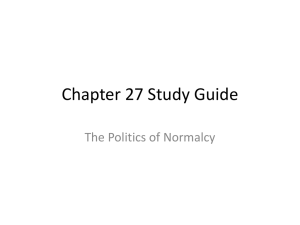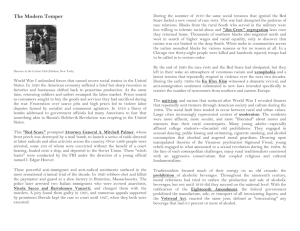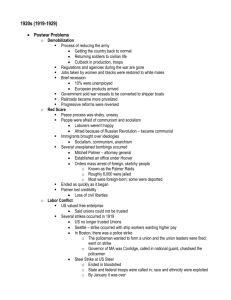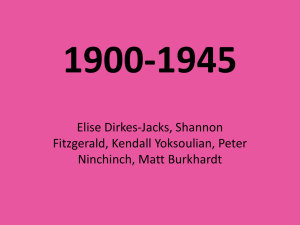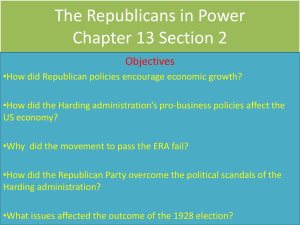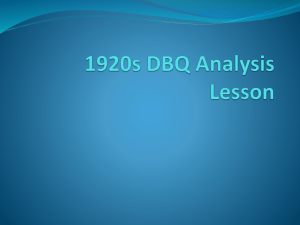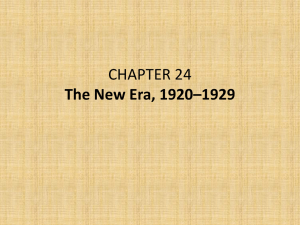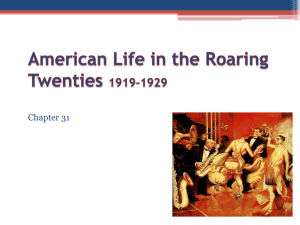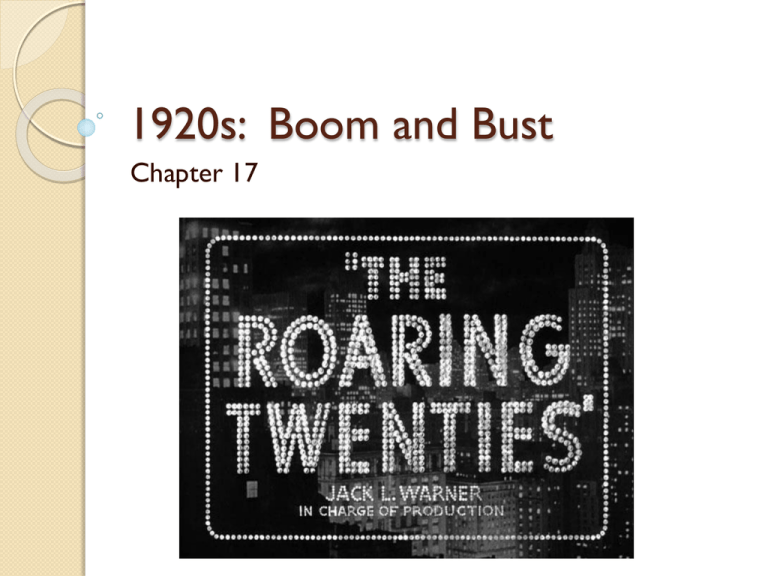
1920s: Boom and Bust
Chapter 17
Sacco and Vanzetti
1921 Most publicized
“red” case- and a
representation of how fear
throws reason out the window.
Nicola Sacco and Bartolomeo Vanzetti (Italian
immigrants) arrested for the murder of a
factory guard in Massachusetts. The main
“evidence” against them was that the men
were known to be anarchists, atheists and draft
dodgers. Sentenced to death in 1927- probably
innocent- case overturned in 1977
The New Economy
Wars are great for the economy (as long as you
aren’t fighting at home) There was a brief recession as
the war ended, but from 1923-29 there was
widespread prosperity and expansion- due in part to
the fact that we were the only major econ left
standing after the war…..Business glorified againCalvin Coolidge said “the man who builds a factory
builds a temple”.
Economy was shifting- industry was becoming based
in consumer goods (ready made clothes, appliances,
electronics etc…) Prices had dropped, wages had
risen; Americans had to spend far less on “necessities”
and had more to spend on “luxuries”. Industrial
productivity rises 70%
White Collar Workers Increasing- in 1900 18% were,
by 1930 44% were
Transportation
We are entering the age of the automobile. Model
T introduced in 1908, and prices went down as
manufacturing became more efficient. By 1920
you could buy one for $400, or pay for it on
credit. General Motors founded.
During the 1920s 23 million cars will be
purchases- which will radically change American
family and social life.
Airplanes invented in 1903- and used in WWI
(flying “aces”) Charles Lindbergh’s solo flight 1927
made him a national hero (with a dark side….)
Amelia Earhart did it in 1931.
Electricity
Also hallmarks of the new consumer
economy. By 1930 2/3 of homes had
electricity (as opposed to 20% before the
war) which could be used not only for light,
but appliances like washing machines,
refrigerators, vacuums etc…, and ½ had
telephones.
Again, prices for these products were
dropping, so things that had been “luxuries”
became commonplace –and people saw
work not as a means to survive, but to be
able to buy what you WANT
Credit
New concept- the installment plan.
During the 1800s the focus had been on thrift,
now consumers are encouraged to buy with
“no money down”, but the idea of “saving” also
fell off- people spend full income
Advertising
Another burgeoning industry.
Buy something not because
you NEED it, but because you
WANT it and “You’re worth it”. Had learned
from success of CPI during war. Celebrity
endorsements, (esp moviestars) catchy
slogans, impossible promises….it’s all there
PR is also born. Businesses would hire people
to promote (or repair) their “image”
Radio
Guglielmo Marconi (Italian
Immigrant) invented radio in
1890. 1st radio station 1920 (KDKA Pittsburgh)
broadcast presidential election of Warren
Harding. NBC founded 1926, CBS 1927- by 1929
there were 10 million radios in the US
Huge with advertising- and allowed people to
experience things as they happened.
Helped create a national culture- could be used
for propaganda, entertainment, politics, almost
anything. “Media” quickly becomes enormously
influential.
Changing American Lifestyles and
Values
1920s witness the birth of a widespread
popular culture that crosses class lines,
age brackets, and regional zones. It was a
little wild and crazy (reflecting the idea
that the old world order had been
destroyed in the chaos of war) and from
this point- every generation pushes the
boundaries
Fads and Fashions
This is the Jazz Age (named by F. Scott
Fitzgerald), with flappers, drinking (illegally)
and smoking in public, dancing in shocking
ways to shocking music (Louis Armstrong,
Duke Ellington and Ella Fitzgerald) all taking
part in a “New Morality” that puts pleasure
before all else, and opens up taboos.
Professional Sports players and Movie Stars
become the the new American Heroes. Silly
competitions (flag sitting)
Farmers and the New Economy
WWI had been great for farmers (they were
feeding Europe and US) but, it encouraged
overproduction, and when war ended, prices
began to drop, tens of thousands of farms were
foreclosed in the 20s.
Mechanization meant that fewer people needed
to be farmers, and migration to cities continued
(majority of Americans became Urban)Farming
also represented a ever decreasing proportion of
the economy, only 12.7% in 1929. Not really able
to take part in the new “prosperity” of the
consumer income- a gap is widening that will
become very problematic their depression
actually starts well before 1929.
Decline of the Labor Movement
Unions became associated with socialism (which
they are), communism and other “radical”
elements. After all, workplaces are much safer
now (after progressive reforms) and many firms
practice “Welfare Capitalism” (benefits like
medical, pensions, even company sports teams)
what else do workers need? Bloody summer of
1919 had seen 4 million workers on strike- and
cost them public support.
Many states passed open shop laws forbidding
unions from forcing membership, and businesses
created blacklists of “union agitators”
The Women’s Movement
19th Amendment approved in
Congress in 1919- ratified in
1920
But while women had the vote, most Americans did not
question that they should remain in their traditional
subordinate roles. Many felt that women needed
additional legal “protections”, to prevent long work
hours, or force men to pay child support.
Divorce laws liberalized in many states- with preference
for child custody going to the mother 1 in 6 marriages
ends in divorce in the 1920s.
Equal Rights Amendment proposed in early 1920s by
Alice Paul- proposed eliminating all legal distinctions
based on sex. Failed (as it did in the 1970s too)
The Politics of Prosperity
Political Pendulum (I like alliteration) swings away
from progressive idealism, especially as it is
discredited by “scientific” theories of Freud and
the unconscious, or, IQ tests which show many
people just aren’t that smart….
Political participation had been falling since 1896,
and by 1924, only 50% of those eligible to vote do.
Republicans control the white house and
congress through the 20s, ushered in by Warren
G Harding’s promise of a return to “normalcy”.
This is where Republicans, the party of reform
under TR and Taft, become more of their modern
conservative selves (the progressive element had
bolted in 1912) and adopt a “Business 1st”
approach.
Presidential Rankings: C-Span Survey, 2009
1.
2.
3.
4.
5.
6.
7.
8.
9.
10.
11.
12.
13.
14.
Abraham Lincoln
Franklin Roosevelt
George Washington
Theodore Roosevelt
Harry Truman
John Kennedy
Thomas Jefferson
Dwight Eisenhower
Woodrow Wilson
Ronald Reagan
Lyndon Johnson
James Polk
Andrew Jackson
James Monroe
15.
16.
17.
18.
19.
20.
21.
22.
23.
24.
25.
26.
27.
28.
Bill Clinton
William McKinley
John Adams
George H.W. Bush
John Quincy Adams
James Madison
Grover Cleveland
Gerald Ford
Ulysses Grant
William Taft
Jimmy Carter
Calvin Coolidge
Richard Nixon
James Garfield
29. Zachary Taylor
30. Benjamin Harrison
31. Martin Van Buren
32. Chester Arthur
33. Rutherford Hayes
34. Herbert Hoover
35. John Tyler
36. George W. Bush
37. Millard Fillmore
38. Warren Harding
39. William Harrison
40. Franklin Pierce
41. Andrew Johnson
42. James Buchanan
The Harding Years
Believed in cooperation between business
and government- with gov’t main job being
to help business make $$.
Harding himself was one of our more “ordinary” presidentsand that was his appeal. The public was tired of big
personalities and crusades and speeches…Harding was just a
normal guy. Though he loved to drink during prohibition, and
was having and was having an affair (and illegitimate child) the
whole time he was in White House
PLUS… he also did a little spoils system…. And while some
were good administrators, others were known as the “ohio
gang” and maybe weren’t good choices for public trust,
several were implicated and convicted of bribes etc….and
therefore Harding ends up fairly far down the list of
American leaders – and probably the “worst” Ohio President
In 1923 Harding died (natural causes- though possibly stress
induced), and his VP Calvin Coolidge took over.
Teapot Dome and Arms Reduction
The biggest scandal came to light after Harding
died.
Secretary of the Interior (Albert Fall) arranged
for the transfer of naval oil reserves in Teapot
Dome Wyoming to his department, and leased
the land to private contractors- accepting a bribe
of $400,000 to do so. Secretary Fall ends up in
prison
One of the best achievements of the Harding
presidency was the Washington Naval Arms
conference in 1922. League of Nations and US
worked together to slow naval buildup, and create
a ratio of ships for 5 major powers (US, Eng, Jap,
Fr, Italy) 5-5-3-1.7-1.7
Calvin Coolidge
Cabinet scandals did not scare
people away from the Rep party, Coolidge won re-election
easily in 1924
Nicknamed “Silent Cal”- he neither offered or achieved much
change…kept tariffs high, taxes low, and businesses running
smoothly. He was a believer in “trickle down” economics:
keep things good for the rich (esp low taxes), and their
wealth will be invested in business which will flow down to
lower levels of society. Deliberately rejected programs that
would help ordinary citizens or local issues, for ex, to help
after a devastating flood that hit Mississippi, or building dams
in Tennessee- these are jobs for local governments and
charities- not the federal system.
Decided not to run in 1928 with the following speech “I do
not choose to run”
A Return to Isolationism
Wilson might have had a vision of the US
exerting international influence, but we’re not so
sure- there is a marked foreign policy retreat
during the 20s exemplified by the fact that we
don’t join the league of nations.
We have occasional activities – like hosting the
Washington Naval Conference on Arms
reduction (look how well that worked) and stay
strong on international economics
Dawes plan: Both the US gov’t
and private banks help
European nations keep going in
20s – esp the Weimar republic in
Germany, loaning them billions so
they can keep making their reparations payments
Conflicts Between Old and New
Values
Obviously not everyone was going to
jump on board with new ideas…
One group strongly opposed were
Evangelical (Born Again) who resented the
secular nature of the age, and the pushing
of boundaries away from biblical
standards
Fought hard when pushed to try and
maintain “traditional values”
Civil Liberties
During the war, the courts had used
a strict interpretation of free speech,
defining “freedom” rather narrowly,
which carried over into 20s.
Censorship of artistic works (esp in films, though
many books banned as well – See Lost
Generation on next slide)
Justice Louis Brandeis instrumental in beginning
shift- first as a dissenter- saying:
◦ “those who won our independence believed in the
freedom to think as you will and speak as you think
are indispensible to the discovery and spread of
political truth”
The Lost Generation
Many people who had survived the war found themselves
struggling to create a place in the world. Traditional values no
longer seemed solid, emerging culture seemed shallow after
all they had been through – what had all that death and
sacrifice been about? Quest to find meaning inspired great
art, esp in literature
Great writers:
◦ TS Elliot- the Waste Land (a collection of poems about pessimism
of the modern world)
◦ F Scott Fitzgerald- The Great Gatsby (the glamour and cruelty of
materialistic society)
◦ Sinclair Lewis – Main Street (debunked small town hypocrisy)
◦ Ernest Hemingway- A Farewell to Arms (disillusionment of WWI)
Ex-patriots- many young intellectuals left US- feeling stifled
by artistic limitations on free speech.
Scopes Trial
In 1925 a Biology teacher
named John Scopes was
arrested in Tennessee for
teaching evolution (which many fundamentalist Christians
felt was representative of a “moral breakdown” in US
Christian values- ACLU had asked for a teacher to
challenge in order to get the case)
Trial became a national sensation- and debate about
freedom of thought. Clarence Darrow (pro) vs. William
Jennings Bryan (against)- broadcast on the radio.
Scopes found guilty, but case essentially disappeared.
Evolution became more accepted in schools. (still
controversial in some)
Prohibition
The last of the great progressive reforms- 18th
amendment ratified in 1919, prohibiting the sale
of alcohol. Unfortunately the age of reform had
passed, and people weren’t really interested in
restriction- they are interested in pushing
boundaries- and this became one more thing to
rebel against
Volstead Act: set criminal penalties for sale- and
created Prohibition Bureau within the Treasury
Department.
At first it seems to go well- by 1921 alcohol
consumptions drops to 1/3 of where it had been
in 1914…. But…
Problems with Prohibition
It’s hard to enforce a ban on something most people
don’t think of as a real crime, plus there are loopholes.
Doctors can “prescribe” alcohol, and it wasn’t a crime
to manufacture or drink- just sell (bathtub gin)
People still want alcohol, and were there is a demand, a
supply will follow. Bootlegging became a huge business,
bars become “speakeasies”.
Organized crime really born in US during 1920sgangsters like Al Capone/Lucky Luciano made $$ off
illegal alcohol, and took care of competition however
they needed to- over 500 gangster related murders in
Chicago in the 1920s, and once prohibition ended,
gangsters moved on to gambling, prostitution, drugs
etc…
Bu 1929 alcohol consumption was 70% of what it had
been in 1914- and the Volstead Act was a national joke
Nativism, Immigration and Racism
Red scare led to calls to restrict immigration- esp from
southern and eastern Europe who are thought to be
polluting “native” values (good news is- we now like
Germans and Irish whom original “know nothings” had
protested)
1921 Immigration Act: Congress limited immigration to
350,000 people a year, 1924 National Origins Act lowered
to 164,000. It also set “quota system” saying that of those
people allowed to come it could only represent 3% of that
country’s immigrants in 1890 (heavily favoring western
Europeans) Cut immigration in half- actually more people
left the country in 1930 than arrived.
No limitations on immigration from other parts of the
Americas- significant numbers of Mexicans and French
Canadians arrive
KKK
Revived in the 20s (Birth of a Nation
1915- great recruiting film- and 1st
“blockbuster” movie in history)targeting not only African Americans,
but immigrants, esp Communists,
Catholics and Jews (you have to be a
WASP to be KKK)
In 1925 there are 5 million klansmenwho make no effort to hide activities
saying that they are “cleansing”
society (they are an extremist
reaction to Jazz age shifts in morality)
Eventually their violence (along with
some other scandals like
embezzlement and affairs) will
discredit
Cultural Pluralism
The idea of a society that embraces ethnic diversity
rather than attempting to suppress it. Some people
looked at immigration restrictions, increased Klan
activity, anti-semitism and anti-catholicism and saidwe need to change this….
Not saying people should assimilate, but boundaries
of a good “American” don’t have to be so narrow.
Anti Defamation League (B’nai B’rith) and NAACP,
and National Catholic Welfare League fought
discriminatory laws
New interpretation of 14th Amendment: Citizenship
means right to “live as you choose with out
interference from the state” (will lead the way for
right to privacy in later decades)
Harlem Renaissance
The same feelings of confidence and despair that existed in
society overall could be found in the African American
community as well. Had fought, worked, and still were not
being allowed to move forward in society.
So they decide to stop “apologizing” and revel in their own
culture “I am Negro, and I am beautiful”. Creators of Ragtime
(Scott Joplin) and Jazz (Louis Armstrong, Duke Ellington)
Moved north from New Orleans- A generation of artists and
writers made Harlem (Cotton Club) a center of poetry,
music, and art that came from African inspiration (Chicago
important as well)
Langston Hughes- poet, voice of Harlem, disillusioned with
society, but proud of culture.
Marcus Garvey- Political leader. United Negro Improvement
Movement- promoted return to Africa, which didn’t happen
often, but spoke of racial pride, reclaiming roots, and
separation by choice as superior group.
Hoover in the White House
Republicans ran Herbert Hoover in
1928, who was well qualified to be
president- had served with distinction as head of
Food Board in WWI and Secretary of Commerce
for 2 administrations. Radio speeches (national
campaigning) significant for the 1st time promising
“Poverty will be banished from the nation, there will
be a chicken in every pot”…and the Democrats ran
Al Smith- a Catholic (Nativist uproar) Even a couple
southern states vote for Hoover!
As Hoover entered the white house in March of
1929 the US had never been more optimistic, more
sure that they were heading towards and endlessly
bright future…..
What Goes Up…..
The Great Depression
The Stock Market Crash: Roots
The Depression came from a variety of factors- a “perfect
storm” of economic issues- and while the Crash was the
explosion, it wasn’t really the start
Overproduction of Agriculture all through 20s- falling crops
prices meant farmers were losing $$, and therefore less able
to buy manufactured goods (so overproduction there too)
Many industries were weak- stuck in 1880s (cotton textile,
RR, coal- the backbones of the 2nd IR).
Uneven distribution of income and taxation from trickle
down. Unstable banking system with no federal protection.
Weak International econ b/c of war and tariffs
Speculation in stocks- with buying “On the Margin” (10%
down, which only works as long as value of stock goes up)
Many people counseled caution- including Hoover
“Easy Credit” was too easy- people in debt
Results
A Recession began in
August of 1929, and then on
October 29th 1929 (Black
Tuesday) a selling frenzy
began- which led to a dip,
then a crash ($30 billion in
“paper profits” lost in a
month)…market and
economy fall until rock
bottom of July 1932
Major blame for gov’t
comes not from letting
crash happen…but for
inactivity once it did….
A world wide issue…..
As market had begun to stumble in early 1929, US
had stopped making loans to Germany… which is
how they had been paying their reparations to
France and England, which is how France and
England had been repaying their war loans to the
US (House of Cards)
As banks struggle in Europe and US with
international $$ issues- they stop making loans to
businesses, who then lay off workers, who then
can’t buy goods
Japan also very hard it- heavily dependent on
exports to US (they fix it by shifting to military
production…)
Effect on the Economy
At first it seemed impossible…things had been so
good for so long- which is one reason that there
was such panic as the fall started (which helped
the bottom drop out entirely)
By 1932- 5,761 banks (22%) had failed, and 20,000
businesses were bankrupt, business investment
had dropped by 95%.
13 million Americans (25% of working population)
were unemployed nationally- as high as 50% in
certain areas- unskilled labor hit hardest
(unemployment had been 3.2% in 1929)
American confidence turns to despair
The Great Depression
Remember- Adam Smith says this is
perfectly normal, and laissez faire
capitalism is the American way (at that
point) so gov’t should just ride it out, and
things will take care of themselves
eventually (the Depression actually ends
up discrediting and destroying this as a
viable theory)
Hoover’s Policies
Hoover is a Laissez Faire guy- and he genuinely thinks
government “Interference” in the econ crisis will hurt
American character he calls “Rugged Individualism”
(determination overcomes adversity) Advocated
“Volunteerism” urging all citizens to contribute to
charities to ease suffering (he donated generously –
his entire pres. salary) and asking business to
economize where possible
Raises the Tariff (Hawley Smoot Tariff 60%) to protect
US Business, which actually made things worse as it
restricted trade
So as the economy continued to freefall….he did very
little (though he did try, and paved way for new
deal)….which is what puts him near the bottom of
the list…..
Presidential Rankings: C-Span Survey, 2009
1.
2.
3.
4.
5.
6.
7.
8.
9.
10.
11.
12.
13.
14.
Abraham Lincoln
Franklin Roosevelt
George Washington
Theodore Roosevelt
Harry Truman
John Kennedy
Thomas Jefferson
Dwight Eisenhower
Woodrow Wilson
Ronald Reagan
Lyndon Johnson
James Polk
Andrew Jackson
James Monroe
15.
16.
17.
18.
19.
20.
21.
22.
23.
24.
25.
26.
27.
28.
Bill Clinton
William McKinley
John Adams
George H.W. Bush
John Quincy Adams
James Madison
Grover Cleveland
Gerald Ford
Ulysses Grant
William Taft
Jimmy Carter
Calvin Coolidge
Richard Nixon
James Garfield
29. Zachary Taylor
30. Benjamin Harrison
31. Martin Van Buren
32. Chester Arthur
33. Rutherford Hayes
34. Herbert Hoover
35. John Tyler
36. George W. Bush
37. Millard Fillmore
38. Warren Harding
39. William Harrison
40. Franklin Pierce
41. Andrew Johnson
42. James Buchanan
Pump Priming
Hoover did feel that the gov’t could put a LITTLE $$
into the econ to jump start.
Gov’t hired people for public works projects (New
Deal will do the same thing- just on a massive scale),
Created an Agricultural Marketing Act (Farm Coops) and The Reconstruction Finance Corporation
(RFC) to lend $500m to banks, who were then
supposed to lend the $$ to start new businesses.
None of these programs were really successful,
Hoover wasn’t willing to create gov’t debt, so didn’t
spend enough for programs to be effective. And
administered foolishly too- gov’t would buy farm
surplus, and throw it away rather than give
“handouts”
Bonus Army
WWI Soldiers were owed a Bonuswhich was to be paid in 1945 (kind
of random in the 1st place) 14,000
veterans marched on Washington in
1932- demanding the bonus.
Senate refused to consider- though
offered soldiers free tickets homeabout ½ accepted. But 5000
marchers lived in shanties for
months and continued to lobby for
their cause.
Hoover called in army to clear
marchers out their camps set on
fire- 2 killed. Made hoover appear
heartless to already angry
Americans
Assessment of Hoover
Often criticized for “not doing enough” but he did
advocate more direct gov’t intervention in the
economy than any previous president.
Prevented a more serious collapse (we could have
been Weimar Republic) and paved way for new deal.
BUT: Refusal of large scale relief resulted in increased
misery – Hoover vetoed
use of federal funds to
be given directly to
public, he thought that
was socialistic and
would destroy the
nation’s work ethic.

